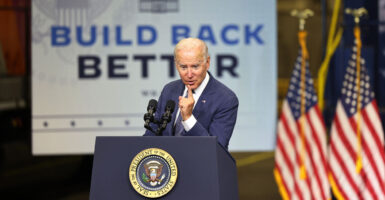Politico is reporting that congressional Democrats are pondering major cuts to Medicare Advantage, a system of competing private health plans, to help pay for their massive multitrillion-dollar spending bill.
This would be a bad policy. Compared to traditional Medicare, Medicare Advantage provides better benefits, lower costs, and higher quality care.
Medicare Advantage is a popular alternative to traditional Medicare. From 2011 to 2020 alone, private plan enrollment grew by 103% compared to overall Medicare growth of 28%. This year, private plans are projected to enroll over 27 million senior and disabled Americans or an estimated 43% of the total Medicare population.
The program’s rapid growth is not hard to explain. It works.
First, Medicare Advantage plans provide a richer set of health benefits, including dental, vision, hearing, and preventive services, as well as protection against the financial devastation of catastrophic illness, a protection absent in traditional Medicare.
In 2020, moreover, Medicare Advantage plans provided the traditional Medicare Part A and Part B benefits that cost on average about 12% less than traditional Medicare.
Second, Medicare Advantage is more convenient and generally less costly for seniors. This year, many of those enrolled in Medicare’s private plans will pay no more than the regular Part B premium to secure traditional Medicare benefits, plus get additional supplemental benefits and vital prescription drug coverage.
By contrast, those enrolled in traditional Medicare not only face an annual $1,484 hospital deductible, but after 60 days of hospitalization, $371 in per diem hospital costs. For Part B, they must also pay the $148.50 monthly Part B premium, a $203 annual Part B deductible, and an array of cost-sharing payments for specific services.
That is why more than eight out of 10 traditional Medicare enrollees are also enrolled in supplemental coverage—to cover crucial gaps in benefit coverage—and many must pay an additional premium for that extra coverage. Traditional Medicare beneficiaries must also pay another monthly premium averaging $31.69 in 2021 for prescription drug coverage.
By contrast, seniors enrolled in Medicare Advantage normally pay one premium for a comprehensive set of benefits plus catastrophic protection, a sensible alternative to traditional Medicare’s complex array of premiums, deductibles, and cost-sharing arrangements.
Third, Medicare Advantage is delivering higher quality care to millions of seniors. Positive findings are mounting in the professional literature.
Researchers recently wrote in Health Affairs, “Evidence from forty-eight studies showed that in most or all comparisons, Medicare Advantage was associated with more preventive care visits, fewer hospital admissions and emergency department visits, shorter hospital and skilled nursing facility lengths of stay, and lower health spending. Medicare Advantage outperformed traditional Medicare in most studies comparing quality of care metrics.”
While internal negotiations among congressional Democrats are still underway and the specifics are yet unclear, independent analysts anticipate that the cuts to Medicare Advantage would be in the range of $100 to $150 billion over a 10-year period.
Whatever the final number, congressional Democrats cannot cut payment for the provision of medical services without hurting the seniors dependent on the provision of those services.
According to Politico, self-styled congressional “progressives” are ostensibly targeting Medicare Advantage because they think its health plan payments are too “generous” and plans’ risk reviews and assessments are “questionable.”
That’s just an excuse.
Sen. Bernie Sanders, I-Vt., and most Democrats in the House of Representatives have a much bigger agenda: the abolition of private health insurance and the creation of a government-controlled system of national health insurance.
The House of Representative’s “Medicare for All” legislation—HR 1976—would not only abolish all private-sector health plans, including employer-sponsored plans, but also private plans offered in the public sector, including the Federal Employees Health Benefits Program and, of course, Medicare Advantage plans.
Though much of the media attention is focused on the potential cost of the Democrats’ final package, which has variously ranged from $5.5 trillion to $3.5 trillion to now $2.3 trillion, it is the policies that are crucial, regardless of the final price tag. In fact, the giant spending bill is “a socialist wish list” crammed with bad public policies, ranging from amnesty for illegal aliens to tax increases and an inflationary spending splurge.
The proposed Medicare Advantage cuts are not about slowing the growth of Medicare spending. The Democrats are not having an epiphany of fiscal responsibility. On the contrary, the Democrats’ giant spending bill would expand the Medicaid entitlement, add new benefits to traditional Medicare (duplicating Medicare Advantage benefits), and expand Obamacare.
Don’t be fooled. The proposed cuts to Medicare Advantage are elemental to the left’s broader health policy agenda: centralize direct control over health care financing and delivery and roll back and reduce the emergence of private alternatives for care and coverage.
For the left, inflicting damage on a successful health program is worth the goal. The goal, of course, is increased power and control over Americans’ health care decisions.
Have an opinion about this article? To sound off, please email letters@DailySignal.com and we’ll consider publishing your edited remarks in our regular “We Hear You” feature. Remember to include the URL or headline of the article plus your name and town and/or state.



























